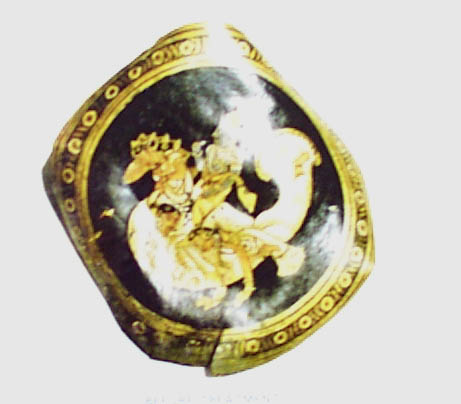|
Storage of Museum
Objects
There is a natural tendency to relax conservation vigilance when the
museum objects are out of sight in storage or vaults. The basic principle of storage is to keep
the objects in a physically secured environment and yet to permit ready access for inspection
before their removal to the galleries, storage or to other locations. There are various storage
devices such as stacking, shelving, drawers and cabinets, sliding screens, compaction devices,
vaults etc., and they are expected to meet the physical and environmental criteria intended for
preserving the museum objects against damages. Sliding screens are introduced in this museum
recently for the storage of paintings. Sliding screens are very common for paintings and flat
works and occasionally for decorative art, or arts, which can be suspended by appropriate hooks.
Such system is economical of floor space and is efficient for examination and retrieval purposes.
|

Shelving of Paintings |

Before
Treatment
|
Painting on Leather
Art on leather originated from Persia. Illustrated manuscripts were bound
with richly decorated leather covers. These covers were either painted with miniatures or leather
tooled and embossed with gold was used. Miniature paintings on leather were found in the form of
royal playing cards. The themes of these cards were primarily based on Hindu mythology. The
processed leather is used as a support for paintings. A ground is prepared by priming the leather.
The subject is drawn and natural colour pigments applied. Varnish is applied as a protective
coating.
Leather being organic in nature easily deteriorates. High humidity
encourages the growth of microorganisms, insects and pests. Dryness leads to brittleness,
wrinkling and hardening of the leather. Dust, grease and dirt obscure the painting. Natural
pollutants like oxides of sulphur, carbon, nitrogen, etc., dissolve in the moisture present in the
atmosphere, resulting in acidity to the leather.
To treat hardened, brittle leather, leather-dressing materials like caster
oil, lemon grass oil or citronella oil in rectified spirit is used. This restores
flexibility. O.1% of chlorophenol is added as fungicide. Wrinkles may be removed by placing the
leather under a weight press. Glycerin and rectified spirit are also used to flatten cupped
leather. Fumigation with thymol and para-dichloro-benzene are required for prevention of insect
and fungal attack. |

After Treatment |

Before
Treatment
|
Oil Painting on
Canvas
The art of painting on canvas was introduced to India from the West. The
cotton or linen canvas is the support. The support is made as a ground for the painting by the
application of primers like lead oxide, zinc oxide, titanium oxide. After drying, the surface is
smoothened and then the painting is executed. In order to keep the pigments protected, a varnish
coating is provided.
Generally, the defects can be in any layer, viz., Support, Ground,
Pigment and Varnish.
The aged varnish layer, which masks the painting, may be removed by
dissolution using rectified spirit as solvent and turpentine as the restrainer. The removal of the
varnish layer makes the painting to look fresh.
Relining using fresh seasoned canvas and a suitable and reversible
adhesive like mastic resin-wax mixture can strengthen the weakened canvas.
The loss of pigments may be restored using fresh pigments by a method
called infilling followed by retouching. |

After Treatment |
|
|
|
|